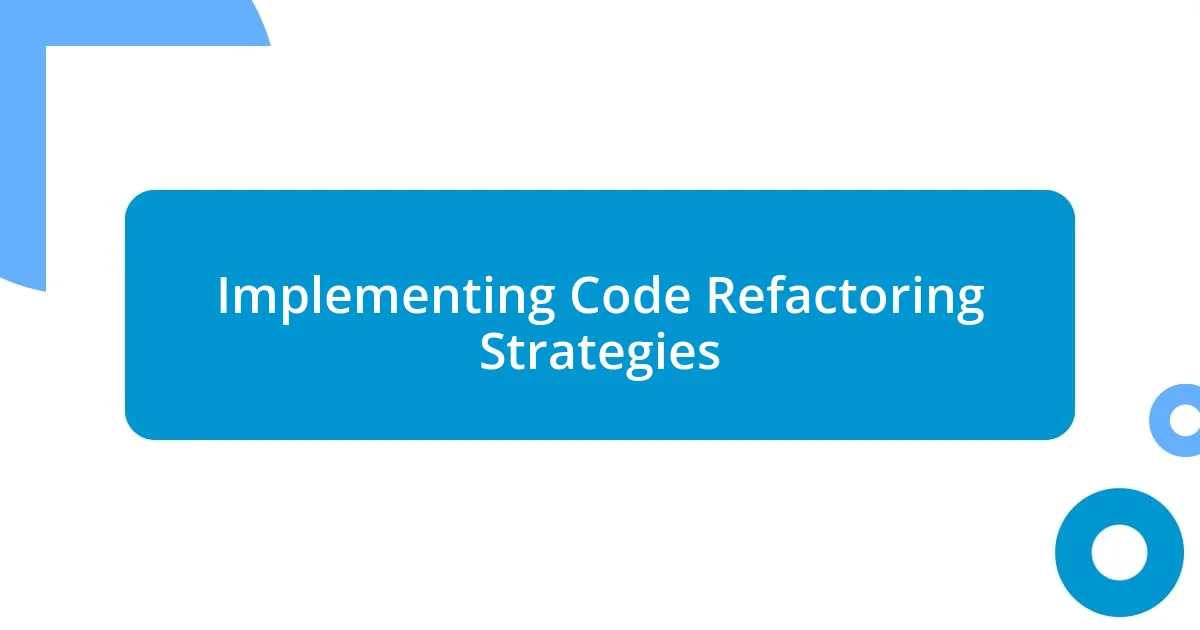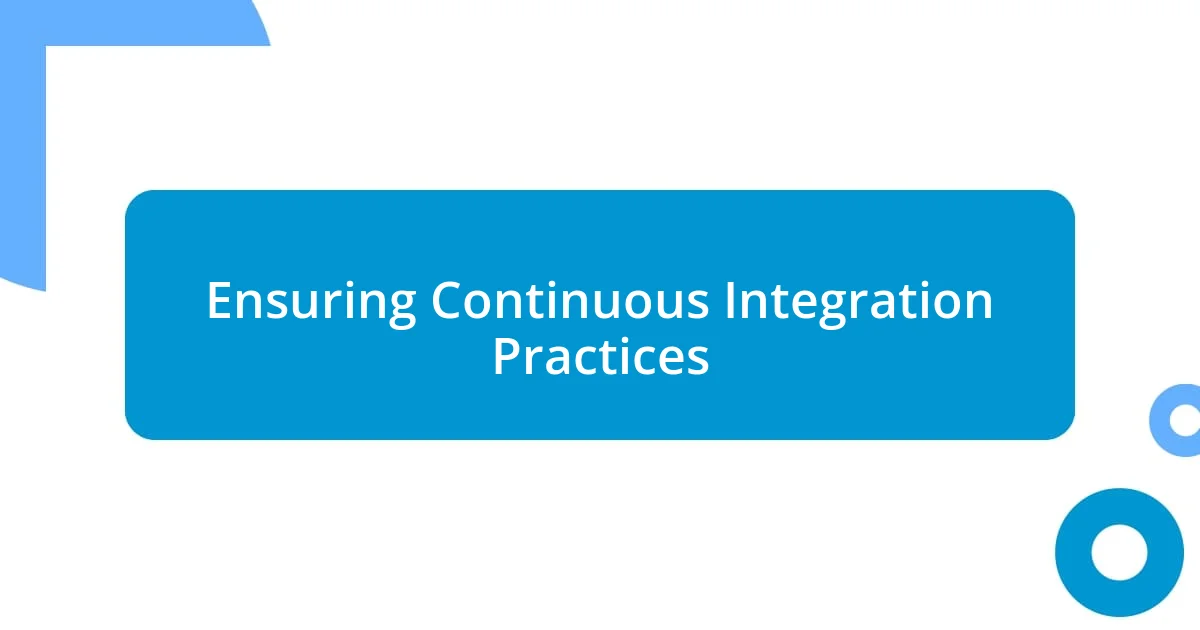Key takeaways:
- Establishing clear code ownership and documentation fosters accountability, enhances collaboration, and boosts team creativity, leading to better code quality.
- Implementing automated testing frameworks helps identify issues early, builds confidence in making changes, and encourages team buy-in through demonstrations of testing benefits.
- Adopting continuous integration practices ensures regular code updates, reduces integration issues, and promotes a culture of shared responsibility, improving overall code health and team dynamics.

Understanding Legacy Code Challenges
When I think about legacy code challenges, I often recall a project where I inherited a codebase with minimal documentation. It felt like navigating a maze in the dark; every time I thought I found a way out, I stumbled upon more twists and turns. Have you ever experienced that sinking feeling when you realize the code you’re working with doesn’t quite make sense?
Another challenge I’ve faced involves dealing with outdated technologies that weren’t backed up by modern tools. I remember trying to implement a new feature in an ancient system only to find that compatibility issues popped up at every turn. It’s infuriating to know that your hands are tied by decisions made long before you were involved. How do we adapt when the tools we need aren’t compatible with the code we’re given?
It’s essential to recognize how legacy systems can create a fear of change among the team. I’ve seen colleagues hesitate to refactor code, worried that their efforts might break something. It makes me wonder—how can we instill a culture of courage and experimentation in teams working with old code? Embracing those risks can be daunting, yet it’s a necessary step toward making meaningful improvements.

Assessing Legacy Code Quality
When I assess legacy code quality, I often start by examining the overall structure and organization. I once encountered a codebase that felt like an overflowing junk drawer—files were scattered everywhere with no rhyme or reason. It was hard to even figure out where to start! A clear, logical structure, on the other hand, fosters maintainability and enhances collaboration among team members.
Here’s what I typically look for during my assessment:
- Commentary: Are comments helpful and up-to-date, or do they confuse more than clarify?
- Test Coverage: Is there sufficient unit and integration testing to catch issues early on?
- Conformance to Standards: Does the code adhere to established coding standards and best practices?
- Duplication: Are there duplicated code segments that can be consolidated to improve efficiency?
- Complexity: Is the code overly complicated, making future modifications intimidating?
By taking a close look at these aspects, I can gauge whether the code is an asset or a liability for future development.

Establishing Code Ownership Practices
When it comes to establishing code ownership practices, clarity and accountability are paramount. I remember leading a project where each piece of code had a designated owner, creating a sense of pride among team members. It wasn’t just about responsibility; it transformed how we approached our work. Have you ever noticed how pride in ownership can motivate developers to produce cleaner, more efficient code?
Moreover, fostering a climate where team members feel empowered to make decisions about their parts of the codebase improves overall collaboration. I once worked with a developer who felt hesitant to voice his ideas due to fear of stepping on toes. But once we implemented clear ownership guidelines, his confidence flourished, leading to innovative solutions that even I hadn’t considered. This experience reinforced my belief that code ownership practices can directly impact a team’s creativity and productivity.
Lastly, documenting these ownership practices is essential. I’ve seen projects suffer due to a lack of transparency regarding who’s responsible for what. A simple organizational chart outlining code owners has made a world of difference for me, as it helps new team members swiftly understand whom to consult on specific sections of the codebase. Without this, navigating projects can feel like wandering through a fog.
| Aspect | Description |
|---|---|
| Clarity | Coding responsibilities should be clearly defined. |
| Empowerment | Encourage team members to own their sections. |
| Documentation | Maintain an organized overview of code ownership. |

Implementing Code Refactoring Strategies
Implementing effective code refactoring strategies is crucial for maintaining a healthy codebase. One approach I’ve found particularly useful is the “Boy Scout Rule,” which suggests that developers should leave the code better than they found it. During a recent project, I took the time to clean up a few messy functions while fixing a bug. Surprisingly, just those small tweaks made a significant improvement in readability, which helped new team members feel more comfortable navigating the code.
It’s easy to overlook areas that need refactoring when you’re caught up in delivering new features. A few months ago, I encountered a module littered with code smells—clunky logic that made the application sluggish. I ran a workshop with my team, where we collectively identified parts of the code that needed attention. By turning refactoring into a shared responsibility and even a fun challenge, we were able to motivate each other to improve the code while also enhancing our collaborative spirit.
Lastly, I can’t stress enough the importance of setting aside dedicated time for refactoring. In one project I led, we adopted regular “refactoring sprints” focused solely on cleaning up the code. This practice not only improved our product’s performance but also created a culture where team members felt valued for their input. Have you ever thought about how much easier your life as a developer could be if you took the time to refine your code regularly? When teams prioritize refactoring, they often find that development becomes smoother and less stressful in the long run.

Developing Automated Testing Frameworks
Developing automated testing frameworks is a game changer when dealing with legacy code. From my experience, creating a robust testing suite not only helps identify problems early but also instills confidence in making necessary changes. I recall a time when I introduced automated unit tests to a legacy system that hadn’t seen any testing in years. The initial discomfort of running these tests was palpable, but the relief I felt watching them run successfully made all the hard work worthwhile.
One of the hurdles I faced was getting the team on board with the testing process. Many were skeptical, viewing it as an unnecessary addition to their workload. I remember hosting a demonstration session showcasing how automated tests can save time during future changes. After some initial resistance, seeing their skepticism transform into enthusiasm was incredibly satisfying. Have you ever witnessed that moment when a team shifts from doubting a process to embracing it wholeheartedly? It’s like unlocking a new level of productivity.
Additionally, ensuring that tests are maintainable is crucial. There was a point in my career when I neglected this aspect, leading to bloated and brittle tests that often broke with minor code changes. I learned the hard way that keeping tests simple and focused is key. It’s like pruning a garden; removing unnecessary branches allows the plants to thrive. I now prioritize creating a living documentation of the testing framework, making it easier for new team members to understand and contribute. This proactive approach has helped us build a resilient codebase, fostering greater collaboration.

Ensuring Continuous Integration Practices
Continuous integration (CI) practices are vital for keeping legacy code healthy and functional. I’ve seen firsthand how setting up a CI pipeline can breathe new life into an older codebase. When I implemented a CI system for a project struggling with countless manual integration issues, the difference was astounding. It transformed our chaotic release process into a smoother, more reliable workflow—eliminating the frustrating late-night debugging sessions that loomed over us before.
One of the most valuable lessons I learned was the importance of frequent integrations. In a previous role, we made it a point to integrate code changes daily. Initially, there were concerns about introducing too many changes at once, but I found that smaller, incremental updates made it easier to catch issues early. Have you ever watched a project flourish simply because everyone involved adopted consistent patterns? It’s like watching a well-rehearsed orchestra; each part plays beautifully without clashing with the others.
Of course, setting up CI is just the beginning. I remember a time when our team struggled with flaky builds due to testing failures. I suggested we maintain a shared responsibility for the CI pipeline, emphasizing that everyone has a role in keeping it green. There was something empowering about that conversation; it transformed the way we approached our coding practices. So, how can your team leverage CI? In my experience, fostering a culture of ownership and collaboration in the CI process not only improves code quality but also strengthens team bonds, making everyone more invested in the outcome.














